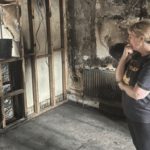Hurricane Helene has wreaked havoc across the southeastern United States, resulting in at least 45 fatalities and leaving millions without power. The storm made landfall overnight on Thursday, striking Florida’s Big Bend as the most powerful storm on record for the region before moving northward through Georgia and the Carolinas.
Rescue operations are ongoing, with officials using boats, helicopters, and large vehicles to assist those trapped in floodwaters. Notably, approximately 50 patients and staff members had to be rescued from the roof of a flooded hospital in Tennessee.
Though Helene has weakened significantly, meteorologists warn that the risks of high winds, flooding, and potential tornadoes persist. The National Hurricane Center reported that the storm surge reached over 15 feet in some areas along the Florida coast, exacerbating the flooding situation. Rainfall accumulations of up to 20 inches are still possible in certain locations.
As Helene transitioned from a Category 4 hurricane to a tropical cyclone, the scale of damage became evident. Financial institutions estimate the storm’s destruction could amount to billions of dollars, with submerged roads and homes reported throughout the affected areas. One family recounted swimming out of their home to reach safety.
Florida has borne the brunt of the storm’s wrath, with at least eight deaths confirmed in the state, including five fatalities in Pinellas County. Sheriff Bob Gualtieri described the coastal region as resembling a “war zone.” Governor Ron DeSantis reported additional deaths caused by falling trees and debris.
After ravaging Florida, the storm continued its deadly trajectory into Georgia, resulting in at least 15 deaths, including that of a first responder. A suspected tornado in Wheeler County overturned a mobile home, contributing to the loss of life. In response, Governor Brian Kemp mobilized 1,000 National Guard troops to assist with rescue efforts.
South Carolina reported at least 17 fatalities, while neighboring North Carolina recorded two deaths, attributed to storm-related incidents. Virginia also reported one death.
By Saturday morning, over three million homes and businesses were without power, according to tracking site poweroutage.us. The federal government had deployed 1,500 emergency personnel, including 940 search and rescue specialists, to aid in recovery efforts.
In Tennessee, swift waters from the Nolichucky River hindered rescue operations, with 58 individuals stranded on a hospital roof until they were finally airlifted to safety. Additionally, numerous rescues occurred throughout Florida, including guests trapped in a flooded Ramada Inn.
As the region begins to assess the damage and recover, President Joe Biden urged residents to heed local officials’ instructions and take precautions for their safety. Officials cautioned that the storm’s effects are far from over, emphasizing the need for continued vigilance.
With the Atlantic hurricane season officially ending on November 30, forecasters warn that more storms could be on the horizon, as sea surface temperatures remain unusually high, fueling potential hurricane activity.

















